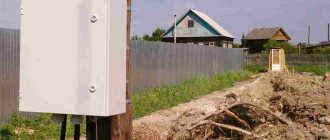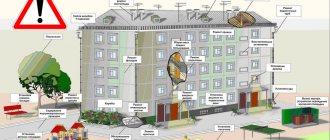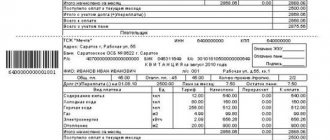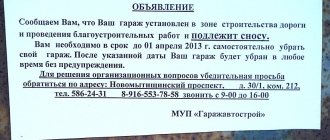How to find your basement in an apartment building.
Legal status of basements
In the Resolution of the Presidium of the Supreme Arbitration Court of the Russian Federation No. 13391/09 of March 2, 2010. installed:
“The legal regime of basement premises, whether or not they belong to the common shared ownership of several owners of premises in such residential buildings, should be determined on the date of privatization of the first apartment in the house.
If, as of the specified moment, the basement premises of a residential building were intended (accounted for, formed) for independent use for purposes not related to the maintenance of the residential building, and were not actually used as common property by the homeowners, then the right of common shared ownership of the homeowners to these premises is not arose. The remaining basement premises, not allocated for independent use, became the common shared property of the homeowners as the common property of the house.
At the same time, to determine the legal regime of the named premises, the presence of engineering communications in them did not and does not matter, since they are located in each basement and do not in themselves give rise to the right of common shared ownership of homeowners for premises already allocated for independent use, not related to maintenance of a residential building.
Since it was the privatization of housing by citizens that was the basis for the appearance of several owners in one house and the emergence of their right of common shared ownership of the common property of the house, including technical floors and basements, this right in relation to each house arose only once - at the time of privatization the first room in the house."
I will express my understanding of the interpretation of the legislation of the Russian Federation by the Presidium of the Supreme Arbitration Court of the Russian Federation.
From the above quote it follows that non-residential premises (basements, attics, etc.) cannot be classified as common shared ownership if, at the time of the first privatization of an apartment in the house, two conditions are met in relation to the non-residential premises of the house:
1. The premises are taken into account and configured for independent use.
2. The premises are not used as common property by the homeowners.
To determine the legal regime of basements, the mere presence of utility lines in them did not and does not matter, since they are located in each basement and do not in themselves give rise to the right of common shared ownership of the homeowners to the premises.
It is important when general engineering equipment is placed in these premises, BEFORE or AFTER the appearance of the first privatized apartment in the house.
That is, if communications and equipment (pipelines for hot and cold water supply, heating, sewerage, shut-off and drain valves and taps, power supply panel) serving more than one apartment in an apartment building are located in the basement before the start of privatization of the apartments, then this should clearly be interpreted as use of premises for the common purposes of the residents of the house, that is, as their use as common property.
This is established by Articles 289, 290 of the Civil Code of the Russian Federation and Article 36 of the Housing Code of the Russian Federation in the constitutional and legal interpretation of the Determination of the Constitutional Court of the Russian Federation No. 489-О-О dated May 19, 2009.
The regulatory document SNIP 31-01-2003, mandatory for use throughout the Russian Federation, defines such basements as technical.
Since communications and general-purpose equipment ensure the livelihoods and safety of residents of an apartment building, such use of basements should be considered a priority.
Consequently, they must be classified as the common property of the owners of the residential premises of the house, even if the first of the listed conditions is met.
If the use of basements for general purposes arose after the moment of the first privatization (for example, the placement of communications and general-purpose equipment, strollers, etc.), after the redistribution of the premises of the house between the owners determined by the legislation of the Russian Federation in accordance with the new forms of ownership that emerged, in addition to the state one ( private, common shared), then if the first condition is met, such basements cannot be classified as common shared property.
The above is fully consistent with both the Determination of the Constitutional Court of the Russian Federation No. 489-О-О dated May 19, 2009, and with the Resolution of the Presidium of the Supreme Arbitration Court of the Russian Federation No. 13391/09 dated March 2, 2010. and concerns primarily apartment buildings built before 1917.
That is, houses in which, after long-term operation, individual stove heating was replaced with central water heating, centralized cold and hot water supply was provided, etc. There are many such houses in our cities.
A different interpretation of Resolution No. 13391/09 of the Supreme Arbitration Court of the Russian Federation contradicts Determination No. 489-O-O of the Constitutional Court of the Russian Federation, the federal legislation of the Russian Federation and, consequently, the Constitution of the Russian Federation.
How to find out the area of the basement in an apartment building.
This list includes the entire list of premises of a multi-storey residential building; you can only add boiler rooms, elevator units, boiler rooms and other spaces with equipment. Private country individual houses In individual construction, the situation is slightly different, since in a private house, as a rule, one owner and his relatives live. However, there are standards for such accommodation. In particular, according to paragraph 4.5 of SNiP 31*02*2005, which regulates the operation of residential single-apartment buildings, the height (meaning from the floor to the ceiling) of the kitchen and living room must be at least 2.7 meters, and other premises - at least 2 ,5 meters. Living rooms and other rooms, including kitchens, located in attics, must be made at least 2.3 meters high. Corridors and rooms with mezzanines measure 2.1 m from floor to ceiling.
Is the basement included in the total area of the house or not?
Rule No. 491) states that the common property includes: “a) premises in an apartment building that are not parts of apartments and intended to serve more than one residential and (or) non-residential premises in this apartment building (hereinafter referred to as common premises), including inter-apartment landings, stairs, elevators, elevator and other shafts, corridors, strollers, attics, technical floors (including built-in garages and areas for motor transport, workshops, technical attics built at the expense of the owners of the premises) and technical basements. Non-residential premises and common areas in an apartment building A detailed explanation of the definition of premises included in the common property is given by the Ministry of Regional Development in letter dated November 22, 2012 No. 29433-VK/19).
The right to an individual place in the basement
Even if the underground floor does not imply the allocation of space for the household needs of residents, there is still a chance to arrange space for the owners of the building. You can allocate an area for storing personal belongings by equipping the ground floor yourself. Despite the presence of communications, the use of the basement in an apartment building is the prerogative of the residents.
The underground floor is common property and belongs to the apartment owners, who have the right to dispose of the compartment at their own discretion. If, at a general meeting, residents of an apartment building express a desire to store jars of cucumbers in the basement or arrange storage for bicycles or car tires in it, nothing and no one can stop them.
What is the total area of an apartment building
Compliance with such parameters is dictated by the comfort of life of the person in the room. According to SNiP 2.08.01-89 (clause 1.41), the height of the basement and ground floor in the house, as well as the underground (technical) from the floor to the lower boundary of the floor slab, must be at least 1.8 meters.
There are several belts for which this height should be 2.7 meters, for others - 2.5 meters. If an individual heating point is being made, then the ceilings are made from 2.2 meters.
The technical underground is a technical floor that is located at the bottom of the building, intended for the location of communications and various equipment.
Access to the basement in an apartment building
Our apartment building has a basement. In this basement there are utility lines serving the residents of the entire entrance - sewerage, water supply, heating, ventilation riser. Suitable locking equipment. In accordance with paragraph 1 of Article 290 of the Civil Code of the Russian Federation and paragraph 1 of Art. 36 of the Housing Code of the Russian Federation, this premises should belong to the residents, but as in many other cases, it was stolen, without a decision of the general meeting of owners, but our pipes remained there. As a result, at night, access to this premises is not possible, no one has the keys No. Accordingly, in the event of an emergency, in the event of a pipe break and flooding, it is not possible to turn off the water, and it is also periodically impossible to turn off the water in the risers for installing plumbing equipment in the apartments of the building's residents. When I had a flood, and the neighbors above were at their dacha, the emergency service could not turn off the water, I stood and looked at these doors and the water flowed all night, if it had been possible to turn off the water, the damage would have been much less, there would have been no damage If there were furniture, there would only be a small leak on the ceiling. I began to study the laws and saw that this situation directly contradicts the legislation in force today in Russia, namely, according to paragraph 3.4.5 of the Resolution of the State Construction Committee of the Russian Federation No. 170 of September 27, 2003.” Entrance doors to the technical underground, basement must be locked (keys are kept in housing maintenance organizations, UDS (United Dispatch Service), the janitor, workers living in these houses), a special inscription is made on the door about the storage location. Access to transit utilities passing through the premises of representatives of the relevant organizations for servicing the housing stock and city utilities must be ensured at any time of the day.” Based on the fact of failure to comply with this provision of the law, I submitted applications to 1. Management company DEZ Gagarinsky district servicing our house.2. To the Administration of the Gagarinsky District of Moscow.3. To the Prefecture of the Southwestern Administrative District.4. To the Moscow Housing Inspectorate. But the only thing they could answer me was that they took the phone number from the owner of this premises. But the law states differently - the keys must be handed over to the control room. In view of the fact that you can find yourself in a similar situation, because your house probably has a basement and probably it is unclear who is in it in the event of an emergency (for example flooding), when every minute counts, you can’t do anything. I ask you to support my complaint and write a similar one in your basement, so that through mass appeal we can force officials to comply with the CURRENT law.
Community "housing and communal services: open platform"
In this case, the values of the total area of all premises in an apartment building, the total area of premises included in the common property in an apartment building, the total area of all residential premises (apartments) and non-residential premises in an apartment building should be determined on the basis of the data contained in the technical passport of the apartment building . The said letter also states that the act on approval of standards for the consumption of utility services reflects the composition of the premises that are common property in an apartment building, the areas of which are taken into account when establishing standards for the consumption of utility services for general house needs (for example, the area of the premises that are part of the common property in apartment buildings, can be determined as part of the areas of vestibules, corridors, staircases, wheelchair spaces, electrical switchboards and service personnel rooms).
Registration of permission to privatize the basement
How is the registration procedure carried out?
There are two types of basements:
- With general access - the residents of the house use them for personal needs (storing personal belongings, storing food supplies).
- Without general access, these are areas that only specialists have the right to enter, since they contain engineering systems.
Let's take a closer look:
- In both cases, the basement in the house is the property of the residents and therefore, in order to make it a private territory, the consent of all owners of the house is necessary. Getting it is not easy.
- In order to resolve the alienation issue positively, it is necessary to vote at a general meeting of the house and document its positive result.
The initial step on this path is to notify all persons who own the basement in an apartment building:
- This can be done through advertisements, by sticking them near each entrance. Residents of the building must be notified 10 days before the start of the meeting.
- Attendance at such an event among owners should be at least 50% of the total.
- In order to transfer part of the basement into private ownership, it is necessary to receive more than half of the positive votes.
The second step is to conduct a vote count:
- During this process, it is strictly forbidden to falsify ballots and protocols.
- Any tenant who disagrees with the alienation procedure has the right to contact the State Inspectorate with a request to verify the results of the voting. In case of falsification, this fact is very easily established.
When the need arises to implement, for example, a commercial idea, for the implementation of which it is necessary to take ownership of a basement located in an administrative building or in a dormitory, the procedure for obtaining consent is no different.
Only there are much fewer owners, which means there will be few obstacles. It will be easier to conclude an agreement.
We suggest you read: Illegal registration in an apartment
Basements are divided into two types:
- those to which public access is allowed. They are used to store personal belongings, food and other things;
- those to which general access is prohibited. Used for engineering systems, access is allowed only to maintenance specialists.
In both cases, the basement is the property of the residents of the apartment building, and therefore privatization will require their approval, which is sometimes difficult to obtain. To obtain it, a meeting of the residents of the house is required, which must be documented and have a positive result. In order for the procedure to be carried out correctly, it is necessary to study the relevant articles in the Housing Code.
The first step is to notify all residents of the apartment building about the meeting:
- They must be notified ten days before the meeting. This can be done with the help of announcements posted at each entrance;
- at least half of the owners must be present at the meeting;
- transfer of the basement to private ownership is possible only if more than half of the positive votes are received.
The second step will be the counting of votes. When carrying out this action, it is prohibited to falsify ballots and protocols. If any of the residents does not agree with privatization and contacts the state inspection body, they will have to provide all documents for verification. If facts of falsification are discovered, punishment will inevitably follow.
It follows from this that when designing a basement, it is necessary to comply with the legal regime so that there are no subsequent problems with the law and opponents of the privatization of these areas.
If you need to acquire ownership of a basement located in dormitories or administrative buildings, you will also need to obtain the consent of the owners. The only difference will be that in this case there are fewer owners, which means that obtaining permission will be simplified.
Question answer
Hello. Does the total area of an apartment building include the area of stairwells, flights of stairs, strollers, and technical rooms? If yes, please provide a link to the regulatory act. Thank you. The question relates to the city of Petropavlovsk-Kamchatsky Good afternoon, thank you for your question.
You should know that by virtue of clause B1.1 of Appendix B of SP 54.13330.2011 “Residential multi-apartment buildings. Updated version of SNiP 31-03-2003”, the area of a residential building should be determined as the sum of the areas of the floors of the building, measured within the internal surfaces of the external walls. The floor area includes the area of balconies, loggias, terraces and verandas, as well as landings and steps, taking into account their area at the level of a given floor.
Buying out the basement from the building's residents
Is it possible to buy out a basement if it belongs to the owners of an apartment building{q} Yes, it is possible, but it is a complicated procedure. Before purchasing a basement, a potential buyer needs to organize a general meeting of the residents of the house.
If the majority of residents agree to sell the premises (there must be at least 75% of the votes), then the transaction is concluded with the participation of the owner of the house (a specific person will act as a representative of all owners and act on their behalf by proxy).
We suggest you read: Is it possible to privatize an apartment by power of attorney?
But buying a basement in this situation is extremely difficult, because in most cases the owners want to use the basement for their own needs.
The total area of the room, bti.basement or underground?
The Government Decree of the Russian Federation dated August thirteen, 2006 (number 491) states that the property common to all owners includes premises in a multi-storey housing stock that are not classified as parts of apartments. They must also be used to ensure the comfortable condition of several rooms of the house, residential or non-residential.
This list includes technical floors (this also includes the garage area built by the owners, car parking areas, workshops and attics), elevators, other shafts, stairs, platforms between floors, technical basements, with communications or installed engineering equipment to provide residential building heating, water, light and other types of utilities.
The larger the living space, the more votes
After a successful meeting, rules for using the basement in an apartment building are established. Whatever conditions and demands the participants put forward, to make a decision, not only the number of owners is taken into account, but also the size of their possessions, i.e. living space. By the way, the meeting can be considered valid only if it was attended by the owners of the housing stock, who have a majority of the votes (more than 50%).
So, for example, the owner of a three-room apartment has more votes than the owner of a one-room apartment. Otherwise, if 50% of the votes are not obtained, the meeting cannot be considered valid. Afterwards, absentee voting is carried out, about which participants will again have to be notified directly. The information sheet indicates the same issues being considered, as well as the exact time and address of the point of delivery of completed forms.
Basements of an apartment building: legal regime
Expert recommendation Thus, all the premises you listed are included in the concept of the total area of the apartment building. Hello! There are special explanations for these questions presented in the Letter of the Ministry of Regional Development of the Russian Federation dated November 22, 2012.
N 29433-VK/19. According to the Letter, the value of the total area of residential premises (apartment), non-residential premises in an apartment building should be determined on the basis of the data contained in the document confirming the right of ownership (use) of premises in an apartment building, a transfer deed or other document on the transfer by the developer of premises in an apartment building , technical passport of a residential premises (apartment) or technical passport of an apartment building.
Calculation of basement area
With such a ceiling height, these spaces cannot be called premises at all (however, they can be called a cellar), since the space inside the house with much higher ceilings officially acquires the status of a room. The use of such space is also regulated. The footage of basements (basement floors of a house) is considered to be the total area of a private house if their height from the floor to the floor slab is more than 1.8 meters.
Moreover, if the underground is used for utilities or equipment placement, then it is excluded from the total area of the house. About the BASEMENT.
Where to find out the area of an apartment building
Such objects include all premises that do not form part of apartments and apartments that are part of the life support system with a number of one or more, including elevator shafts, stairwells, basements and attics, technical basements and other similar premises. The remaining premises of the apartment building cannot belong to other owners and should not be intended to meet the needs of any social or domestic persons, including premises for leisure activities, cultural facilities, children's creativity or sports. According to the Rules for the maintenance of property owned by all residents in a multi-storey building on equal rights, in paragraph.
One of the most common questions when constructing new buildings or putting them into operation is the legal status of the building, its area from a legislative point of view and the inclusion of the areas of basements and attics in the total footage. The content of the article
- Apartment buildings
- Private country houses
To find out whether the basement area is included in the total area of the residential building, you need to study both multi-apartment residential buildings and private cottage construction.
Apartment buildings It is necessary to immediately clarify that attics, like basements, in their area do not add up to the main footage of the house. These spaces are classified as the common area of the apartment building.
Permitted activities/business in the basement
Some enterprising citizens dream of renting a basement and using it for their business. What can be opened in the basement that is not prohibited by law{q}
Before moving on to the question of what kind of activity a tenant can engage in in the basement of an apartment building, it is necessary to understand that before starting his vigorous activity, a general meeting of all owners of the house should be held, raising the issue of renting the basement and the activities that will take place there , and then also obtain the consent of all owners to carry out business activities.
We invite you to read: Instructions for indoor temperature conditions
When choosing a particular type of business, the tenant must take into account the following features and rules of use, which he must not violate:
- The basement must have good air ventilation.
- There should not be more than 50 people in the basement at the same time - according to fire safety rules.
- It is forbidden to place sales shops or warehouses for storing chemical goods in basements, during the operation of which the territory of the premises or the air may be polluted.
- It is prohibited to place explosive substances and materials in the basement.
- You cannot open a nightclub or similar establishments in the basement, otherwise the noise and music will disturb the residents of the house. For this reason, it is prohibited to organize activities in the basement that create noise or emit odors: dry cleaning, laundry, etc.
- It is forbidden to install swimming pools, saunas, steam rooms, medical institutions, funeral services, etc. in the basement.
- The law prohibits tenants from placing synthetic carpets, auto parts, tires, and automobile oils in the basement to avoid basement fires.
- You cannot organize a business selling fish in a basement.
- The tenant's working hours must be agreed upon with the municipality. But in practice, the law prohibits any activity in the basement after 23:00.
- The tenant or buyer of the basement is prohibited from using common areas - elevator, stairs, corridors.
- If the tenant decides to open a store or office in the basement, then he must make a separate entrance.









